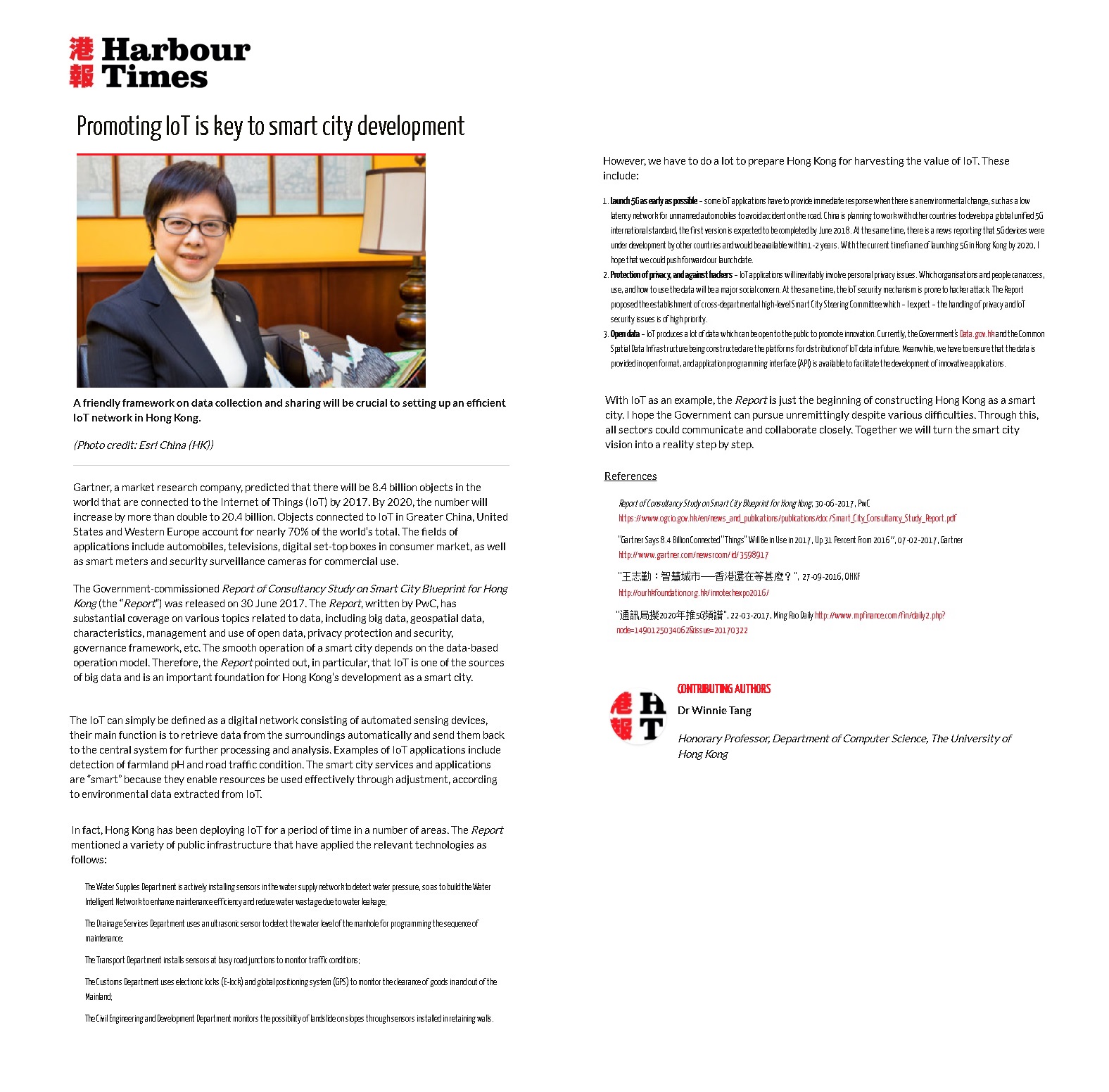網上版請按此

Promoting IoT is key to smart city development
Gartner, a market research company, predicted that there will be 8.4 billion objects in the world that are connected to the Internet of Things (IoT) by 2017. By 2020, the number will increase by more than double to 20.4 billion. Objects connected to IoT in Greater China, United States and Western Europe account for nearly 70% of the world's total. The fields of applications include automobiles, televisions, digital set-top boxes in consumer market, as well as smart meters and security surveillance cameras for commercial use.
The Government-commissioned Report of Consultancy Study on Smart City Blueprint for Hong Kong (the “Report“) was released on 30 June 2017. The Report, written by PwC, has substantial coverage on various topics related to data, including big data, geospatial data, characteristics, management and use of open data, privacy protection and security, governance framework, etc. The smooth operation of a smart city depends on the data-based operation model. Therefore, the Report pointed out, in particular, that IoT is one of the sources of big data and is an important foundation for Hong Kong's development as a smart city.
The IoT can simply be defined as a digital network consisting of automated sensing devices, their main function is to retrieve data from the surroundings automatically and send them back to the central system for further processing and analysis. Examples of IoT applications include detection of farmland pH and road traffic condition. The smart city services and applications are “smart” because they enable resources be used effectively through adjustment, according to environmental data extracted from IoT.
In fact, Hong Kong has been deploying IoT for a period of time in a number of areas. The Report mentioned a variety of public infrastructure that have applied the relevant technologies as follows:
The Water Supplies Department is actively installing sensors in the water supply network to detect water pressure, so as to build the Water Intelligent Network to enhance maintenance efficiency and reduce water wastage due to water leakage;
The Drainage Services Department uses an ultrasonic sensor to detect the water level of the manhole for programming the sequence of maintenance;
The Transport Department installs sensors at busy road junctions to monitor traffic conditions;
The Customs Department uses electronic locks (E-lock) and global positioning system (GPS) to monitor the clearance of goods in and out of the Mainland;
The Civil Engineering and Development Department monitors the possibility of landslide on slopes through sensors installed in retaining walls.
However, we have to do a lot to prepare Hong Kong for harvesting the value of IoT. These include:
Launch 5G as early as possible – some IoT applications have to provide immediate response when there is an environmental change, such as a low latency network for unmanned automobiles to avoid accident on the road. China is planning to work with other countries to develop a global unified 5G international standard, the first version is expected to be completed by June 2018. At the same time, there is a news reporting that 5G devices were under development by other countries and would be available within 1-2 years. With the current timeframe of launching 5G in Hong Kong by 2020, I hope that we could push forward our launch date.
Protection of privacy, and against hackers – IoT applications will inevitably involve personal privacy issues. Which organisations and people can access, use, and how to use the data will be a major social concern. At the same time, the IoT security mechanism is prone to hacker attack. The Report proposed the establishment of cross-departmental high-level Smart City Steering Committee which – I expect – the handling of privacy and IoT security issues is of high priority.
Open data – IoT produces a lot of data which can be open to the public to promote innovation. Currently, the Government’s Data.gov.hk and the Common Spatial Data Infrastructure being constructed are the platforms for distribution of IoT data in future. Meanwhile, we have to ensure that the data is provided in open format, and application programming interface (API) is available to facilitate the development of innovative applications.
With IoT as an example, the Report is just the beginning of constructing Hong Kong as a smart city. I hope the Government can pursue unremittingly despite various difficulties. Through this, all sectors could communicate and collaborate closely. Together we will turn the smart city vision into a reality step by step.
Dr. Winnie Tang
Honorary Professor, Department of Computer Science, The University of Hong Kong